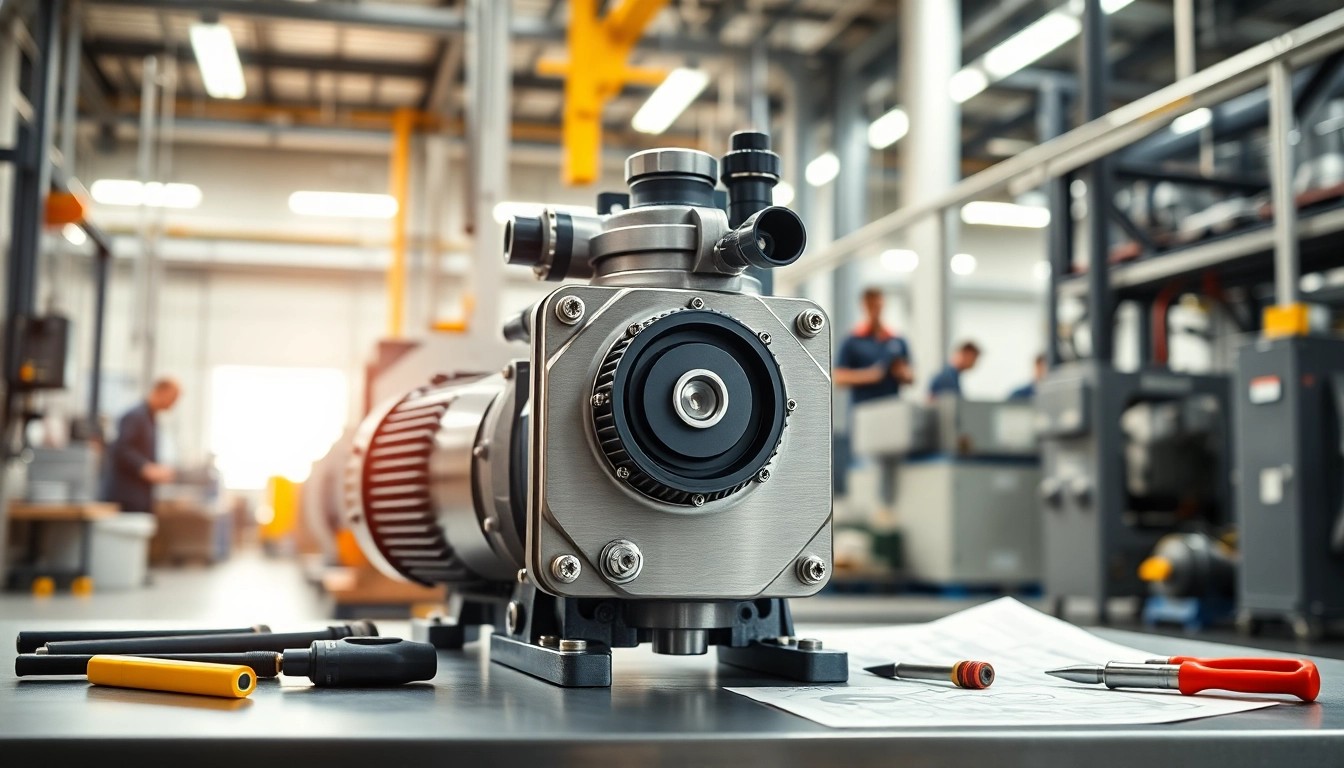Understanding Busch Vacuum Pumps
What is a Busch Vacuum Pump?
A Busch vacuum pump is a specialized device designed to remove gas molecules from a sealed volume. This action creates a partial vacuum, which is essential in various industrial and laboratory applications. The technology is named after Dr.-Ing. K. Busch GmbH, a leading manufacturer in the field since 1963. Busch’s innovations have significantly contributed to vacuum technology, offering reliable and efficient solutions that cater to a broad spectrum of industries, including pharmaceuticals, food processing, and environmental applications.
Common Applications of Busch Vacuum Pumps
Busch vacuum pumps are employed in a myriad of industries, thanks to their versatility. Common applications include:
- Food Processing: Vacuum sealing helps prolong shelf life by reducing oxygen exposure.
- Pharmaceuticals: Used in freeze-drying processes and sterile packaging to maintain integrity and sterility.
- Chemical Engineering: Essential for solvent recovery and distillation processes.
- Electronics: Ensuring a clean and controlled environment during component fabrication.
- Medical Applications: Creating a vacuum for suction devices and other medical equipment.
- Automation and Robotics: Used in material handling and packaging systems to lift and move components.
Benefits of Using Busch Vacuum Pumps
The advantages of Busch vacuum pumps extend far beyond their basic functionality. Here are some key benefits:
- Efficiency: Busch pumps are known for their energy efficiency, leading to lower operational costs.
- Reliability: Built using high-quality materials and advanced technology, these pumps require minimal maintenance, offering long service life.
- Versatility: With a variety of models available, there is a suitable solution for virtually every application.
- Customer Support: Busch provides comprehensive technical support and service networks, ensuring users have access to expertise when needed.
- Innovative Technologies: Continuous development in their product lines incorporates the latest technologies to improve performance and sustainability.
Types of Busch Vacuum Pumps
Busch provides an extensive range of vacuum pumps tailored for specific applications. Understanding these types can help users select the right equipment for their needs.
Rotary Vane Pumps
Rotary vane pumps are among the most widely used vacuum pumps in the Busch line. They function by trapping gas in a series of rotating vanes, providing consistent vacuum performance. Key features include:
- Reliability: Proven technology with significant operational history.
- Cost-Effectiveness: Suitable for a range of applications, offering balance between performance and price.
- Maintenance: Simpler maintenance requirements due to fewer moving parts.
Scroll Pumps
Scroll pumps offer a dry, oil-free vacuum solution, ideal for applications where contamination is a concern. Their design minimizes wear and tear, ensuring longer life cycles and minimal maintenance.
- Clean Operation: No oil means no contamination risk in processes.
- High Efficiency: Offers superior pumping speeds and lower power consumption.
- Noise Reduction: Quieter operation compared to other pump types makes them suitable for laboratory environments.
Dry Pumps
Dry pumps are designed for applications requiring oil-free vacuum. They operate without oil lubrication, making them ideal for sensitive processes such as semiconductor manufacturing.
- Environmental Sustainability: Reduced risk of oil contamination leads to a more sustainable operation.
- Versatility: Suitable for abrasive and corrosive materials without the risk of pump damage.
- Maintenance Efficiency: Longer intervals between maintenance and downtime.
Choosing the Right Busch Vacuum Pump for Your Needs
Selecting the right vacuum pump is crucial for achieving operational efficiency. Here are some key considerations and metrics to assess when choosing a Busch vacuum pump:
Key Considerations
When evaluating your options, consider the following factors:
- Application Requirements: Understanding the specific needs of your process helps in selecting the right type.
- Pumping Speed: Assess the necessary pumping speed to ensure efficiency during operations.
- Ultimate Pressure: Determine the vacuum level required for your application.
- Environmental Concerns: Choose pumps that align with your sustainability goals, considering options like dry pumps.
- Space Constraints: Consider the physical dimensions of the pump and whether it fits into your workspace.
Performance Metrics to Assess
Relevant performance metrics include:
- Flow Rate: The amount of gas the pump can move per unit time; higher is often better, depending on the application.
- Ultimate Volume: The maximum vacuum that can be obtained; essential for applications requiring deep vacuum.
- Noise Level: Especially important in lab environments where a quiet operation is necessary.
Comparative Analysis with Competitors
When comparing Busch vacuum pumps to competitors, analyze:
- Price vs. Performance: Evaluate if the performance enhancements justify the cost.
- Technological Innovations: Check for unique features that may provide advantages in specific applications.
- Service Networks: Consider the availability of service support for maintenance and emergency repairs.
Maintenance and Troubleshooting for Busch Vacuum Pumps
To ensure long-lasting performance, proper maintenance is crucial. Below are tips and common issues you may encounter:
Essential Maintenance Tips
Regular maintenance routines can prevent significant breakdowns. Consider these practices:
- Regular Inspections: Check for leaks or wear to avoid operational inefficiencies.
- Filter Maintenance: Clean or replace filters regularly to ensure optimal airflow.
- Lubrication: For oil-lubricated pumps, maintain appropriate oil levels and quality.
- Keep Records: Document all maintenance activities to track performance and identify recurring issues.
Common Issues and Solutions
Several common issues may arise during the operation of Busch vacuum pumps:
- Insufficient Vacuum: Could result from blocked filters; check and replace them if needed.
- Unusual Noises: Inspect for loose or damaged components, which may require replacement or adjustment.
- Overheating: Ensure adequate ventilation around the pump and check fluid levels if applicable.
When to Seek Professional Help
If issues persist despite routine maintenance, it may be time to consult a professional. Signs that help is needed include:
- Frequent breakdowns: If problems arise more than once, expert analysis may be needed.
- Improving Efficiency: Professionals can provide upgrades or replacements for older models that are less efficient.
- Technical Complexity: Issues that go beyond basic mechanical problems may require expert intervention.
Future Trends in Vacuum Technology
The vacuum technology field continuously evolves, with several trends emerging that may affect Busch vacuum pumps in the coming years:
Innovations in Busch Vacuum Pumps
Busch is committed to innovative technologies that enhance performance and efficiency. Future innovations may include:
- Smart Technology: Incorporating IoT capabilities to allow real-time monitoring and adjustments.
- Improved Energy Efficiency: Further developments aimed at reducing power consumption while maintaining performance.
- Advanced Materials: Using nanotechnology or composites to enhance pump durability and performance.
Sustainability in Vacuum Solutions
With increasing focus on environmental sustainability, Busch is likely to enhance its commitment to eco-friendly practices:
- Oil-Free Solutions: Continued development of dry pumps that eliminate oil usage in operations.
- Recyclable Materials: Designing pumps with materials that can be more easily recycled at end-of-life.
- Energy Recovery Systems: Implementing systems to capture energy from operations for reuse.
The Role of Automation in Vacuum Systems
Automation is transforming various industries, and vacuum technology is no exception:
- Automated Monitoring: Systems that track and report on vacuum performance can help in predictive maintenance.
- Integration with Manufacturing Processes: Seamless connection of vacuum systems with advanced manufacturing techniques will improve efficiency.
- Remote Operations: Enhancements in remote operation capabilities allow users to control systems from anywhere, improving safety and efficiency.















Leave a Reply